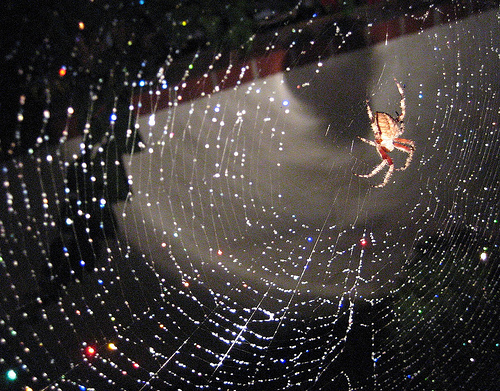Stardust Dreamweaver (Arachnidius centauri)
One of the most deadly of all Martian spiders, the Stardust Dreamweaver doesn’t inject venom into its prey directly. Instead, it surrounds it in a hazy cosmic jive, distracting its victim. Easily trapping its meal, the Stardust Dreamweaver then cocoons it in a hideous kabuki-style space age outfit and subjects it to Gary Glitter’s “Rock and Roll (Part 2),” also known as the “Hey Song.” Once the victim’s brain hemorrhages, the Stardust Dreamweaver devours its prey.
This arachnid dwells deep within the velvet goldmines of the United Kingdom. It is prized by garment makers for its ability to spin webs of pure, sequined polyester.
Manlady Longleg (Pholcus transvestis)
Noted for its long black hair and animal grace, this spider is a sexual polymorph, a chimera bridging the gap between masculine and feminine. In short, it is a mama-papa coming for you (if you are within its striking radius).
Even though it has prominent male organs, this arachnid can be mistaken for a female, altering its markings at will. In addition, its smooth, curvaceous legs are five to six times the length of its entire body, causing it to move like a tiger on Vaseline.
When it is time to mate, the Manlady Longleg performs an elaborate, sadistic courtship dance that could only come from a planet entirely foreign to our own. After cornering its chosen companion, saliva glands become engorged and a long tongue protrudes. It then uses this proboscis to coax discordant melodies out of the other spider, gathering the legs of its mate like the strings of a guitar.
The first scientific observation of this sexual act took place in a New York research facility in 1972 by noted arachnologist Dr. Gene Simmons.
Suffragette City Spider (Cadi stantonious)
A fierce hunter, this vertebrate spider—in a technique described by arachnologists as “wham, bam, thank you ma’am”—first lands on its kill from above, strikes once, and then shakes its victim’s antennae and smiles, resembling a gesture of thanks, albeit a primordial and disturbing one.
The Suffragette City Spider’s erratic behavior continues into mating. It is forbidden for the male to lean on the female at any time during intercourse. If he does, the female will put his spine out of place.
Because of the combination of deadly hunting and reproductive techniques, the female of the species is a total blam-blam.
Orange-Haired Widow (Follicus mulletudinal)
Though Homer wrote that the Abantes warriors wore their “forelocks cropped, hair grown long in the back,” for centuries, no one actually knew what the mullet looked like. Today, thanks to the invasion of the Orange-Haired Widow, the mullet enjoys a popular renaissance, with many derivations on its theme.
The eccentric coloration of this arachnid does not end at the forelocks, however. Across its rightmost set of eyes is a red lightning bolt figure. This marking has the dual benefit of frightening predators while attracting young, impressionable prey. After a deceptive sexual dance (that in fact resembles mime), the Orange-Haired Widow sinks its fangs into its victim and its mullet puffs out. A rule of thumb for those in the field: The bigger the mullet, the deadlier the spider.
Sparkly Tarantula (Scintillatus lysergis)
Beautiful to behold, but a horror to touch, the Sparkly Tarantula is perhaps the Granddaddy of all Martian spiders, and certainly the most formidable. Laced into its venom is a powerful hallucinogen. Minutes into being attacked, the victim is mentally transported to a hellish spaceship disco. Once total-mind control has been achieved, a creature known as the Nazz appears, its God-given ass shining in the disco lights. The Nazz ravages the victim, making love with its ego. After the prey gets sucked up into its mind, the Nazz leaves its victim to hang.
Sparkly Tarantulas shed their exoskeleton to grow; at the end of its lifecycle, the Sparky Tarantula loses its glitter and dons a suit and tie. It is no longer a Spider From Mars. It is now a Diamond Dog.



